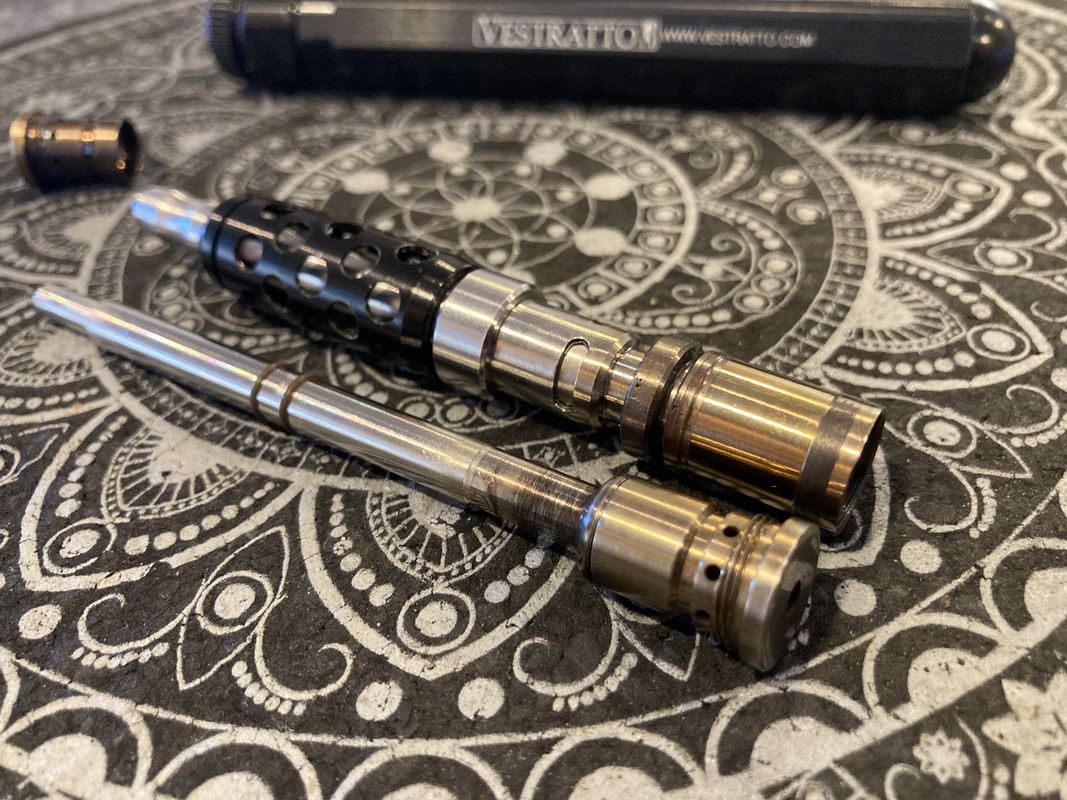I've been doing lots of tinkering because I'm someone who is overly concerned about evenly roasted AVB. For reference, I'm ideally looking for a crafty/mighty dosing capsule, 200C fully extracted without stirring, quality of extraction. Unreasonable for 100% convection vapes, I know, but that's what I'm aiming for always.
I've found that getting a fairly dark Anvil roast by leaving the flame in one place for the whole heating cycle caused darker AVB at one or other end of the load in the herb chamber. Most people won't be bothered by this but I wanted better.
Currently I'm getting the results I want (even and dark rolling tobacco coloured AVB) snapping it at 45 seconds. The first 25 seconds are right on the main copper battery ring and the final 20 are in the middle of the main steel band of the heating chamber. I've been using both the large and small terp chambers even for small 0.05g loads. The above heating style gives the results I'm looking for using either chamber with any size load.
Anyone experienced any hotspot issues or used stylised techniques like the above yet?
I'm having such fun with the Anvil and can't remember wanting to put loads through a vape as much as this for ages, it's a great vape for testing on. Haven't thanked you yet John, cheers for bringing smiles to my face.
Hi there- John here.
They said the guys on FC were the best place to go for feedback. They weren't kidding! These are very detailed and thoughtful observations. Thank you
My experience with the current herb chamber, which is based on a 0.320" industry standard screen size, is that you can get a slight abv colour gradation - slightly darker on bottom- lighter on top. My theory is that - as one draws in convection air - the top of the bowl is kept cooler as it is first heat tempered by the steam liberated from the bottom, then by the vapour, and only once the bottom is fully extracted by pure convection air. There are two experiences from earlier versions that are relevant here and I appreciate your thoughts.
The effect was even more pronounced when we had just air access holes on the side of the unit modelled after what we were familiar with. I introduced the "herb between two screens" design to maximize air access. This definitely improved the situation as it removed the radial component of the colour variations. That was a great move and we have stuck with it.
The second anecdote is more relevant to some who might want a harder hitting version in the future. The diameter of the first generations of ovens, measured at the stainless section, was 0.55". The first screens were 0.384" diameter. That compares to 0.48" and 0.32" today.
You can imagine with a bowl today's depth and the 0.384 width this led to the now infamous "Where am I trials?". But it is very relevant for this discussion. The wider screen allowed us to dose the same amount with a much flatter aspect ratio. Play this thought experiment with me. If we could increase the surface area of the screen to the point that the depth is just one flake of herb across the entire bowl then the entire load would be flash vaporized in the first instant at the same heat. At the other end of the spectrum if we reduce the screen size to the point where we need to stack the herb flakes one atop the other the bottom of the bowl would be vaporized while possibly seconds later the top, a long way away, would still be green. For the Anvil I made the decision to change to a middle ground 0.320" screen for the following reasons
1) the larger oven pushes you into triple and quad torches and butane and time become real issues
2) the larger oven seemed to only have one speed - red line - remember I started with the then current technology "doses" and thought that 0.2-0.5 were commonplace. When you move that amount of herb in a session ok, but in one hit, it seemed excessive.
2) the desire at some point to have induction compatibility with a battery powered device
3) the improved efficiency of the CopperBlock heat reservoir mitigated the abv striation and introduced estratto (roast) control
4) moving the screen of the condenser right to the opening and reducing the "plunger mass" mitigated the striation further
5) compatible 0.320" screens are readily availability in everyone's drawers so if anything happens to Vestratto no one is left high and dry
6) industry acceptance - its pretty hard to be criticized if you follow the market leader - or is it? I thought standardized parts improve a consumers life and have been perplexed by the backlash.
If you visit the Vestratto instagram page you can see this story playing out in pictures in our most recent post over five pre-Anvil generations. There are more intermediate interactions but these give you that evolutionary feel.




